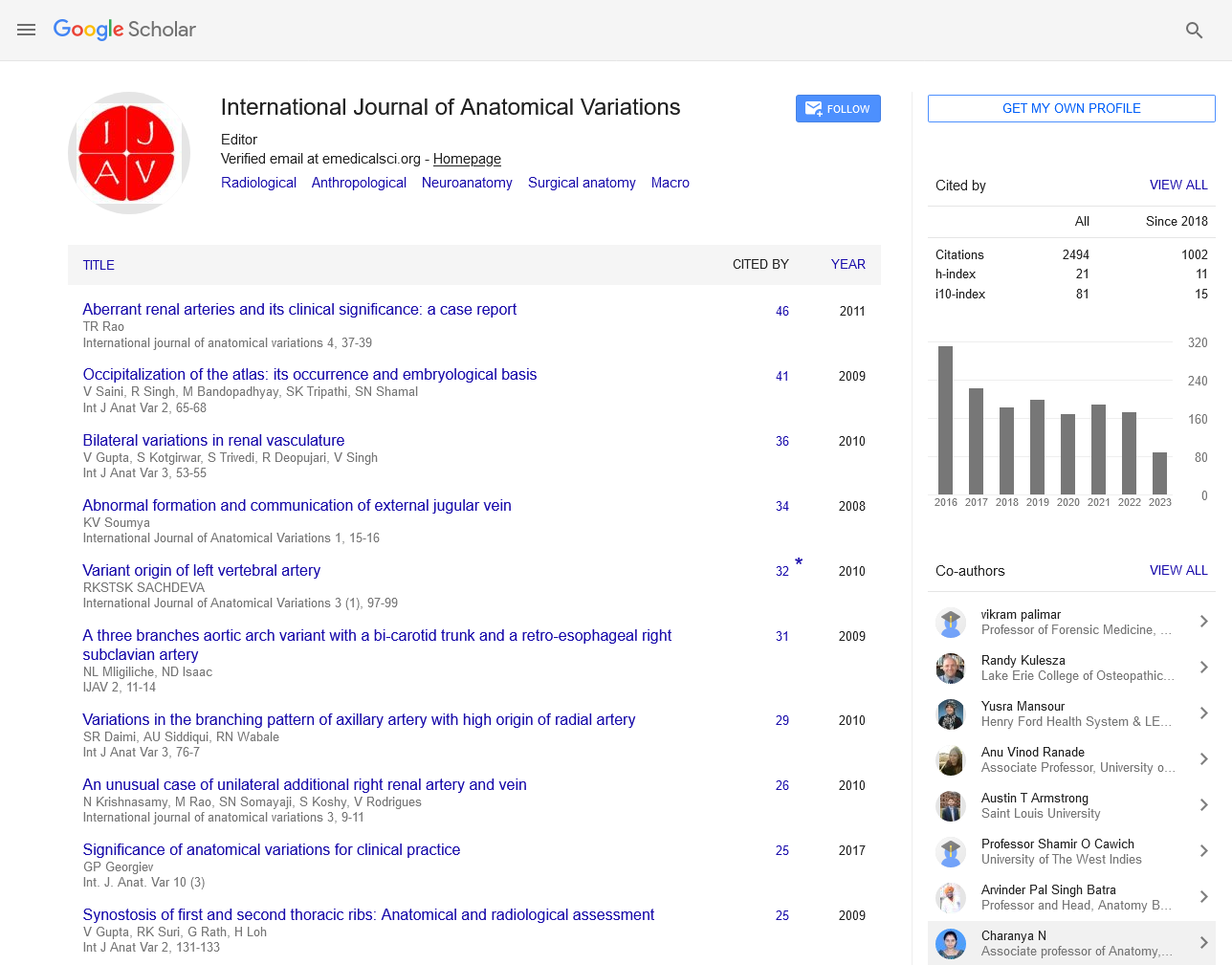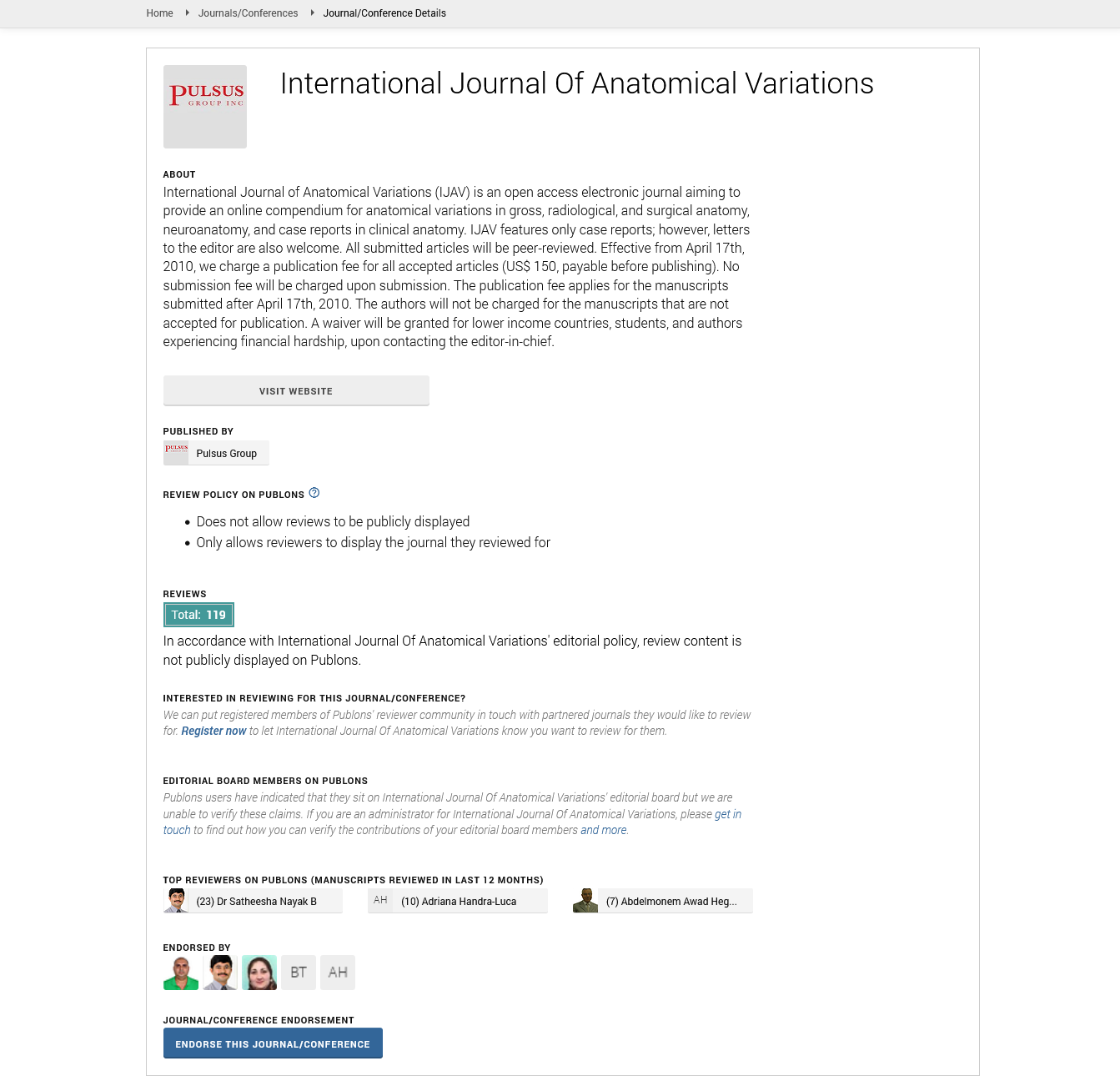Uncommon Variations in the Anatomy of the Temporal Bone: Clinical Relevance in Otologic and Neurosurgical Procedures
Received: 02-Dec-2024, Manuscript No. ijav-24-7360; Editor assigned: 04-Dec-2024, Pre QC No. ijav-24-7360 (PQ); Reviewed: 18-Dec-2024 QC No. ijav-24-7360; Revised: 26-Dec-2024, Manuscript No. ijav-24-7360 (R); Published: 31-Dec-2024, DOI: 10.37532/1308-4038.17(12).467
Citation: Krauseneck J. Uncommon Variations in the Anatomy of the Temporal Bone Clinical Relevance in Otologic and Neurosurgical Procedures. Int J Anat Var. 2024;17(12): 703-704.
This open-access article is distributed under the terms of the Creative Commons Attribution Non-Commercial License (CC BY-NC) (http://creativecommons.org/licenses/by-nc/4.0/), which permits reuse, distribution and reproduction of the article, provided that the original work is properly cited and the reuse is restricted to noncommercial purposes. For commercial reuse, contact reprints@pulsus.com
Abstract
The temporal bone, a complex structure housing vital components of the auditory, vestibular, and neurovascular systems, plays a crucial role in otologic and neurosurgical procedures. Anatomical variations within the temporal bone, though often subtle, can significantly influence surgical outcomes, complicating procedures such as cochlear implantation, mastoidectomy, and skull base surgery. This review explores common and uncommon anatomical variations of the temporal bone, including facial nerve anomalies, variations in the mastoid air cell system, internal auditory canal abnormalities, and temporal bone fractures. These variations can increase the risk of surgical complications, including nerve damage, hearing loss, and poor postoperative recovery. The identification of these variations through advanced preoperative imaging techniques such as CT and MRI is essential for optimizing surgical planning, reducing risks, and improving outcomes in otologic and neurosurgical interventions. Understanding these anatomical differences enables surgeons to adapt their techniques, ensuring safer and more effective procedures.
Keywords
Temporal bone; Anatomical variations; Otologic surgery; Neurosurgery; Cochlear implantation; Mastoidectomy; Skull base surgery; Temporal bone fractures; Surgical complications
INTRODUCTION
The temporal bone is a critical structure in the human skull, housing vital components of the auditory and vestibular systems as well as crucial neurovascular structures. Anatomical variations in the temporal bone, though often subtle, can significantly affect the outcome of otologic and neurosurgical procedures. These variations, which include altered configurations of the middle ear, mastoid air cells, facial nerve, and vestibulocochlear structures, may complicate surgeries such as cochlear implantation, mastoidectomy, and skull base surgery. The significance of these variations lies in their potential to influence surgical planning, increase the risk of complications, and affect post-operative recovery. This article explores the uncommon anatomical variations of the temporal bone and their clinical relevance, focusing on otologic and neurosurgical interventions [1].
THE ANATOMY OF THE TEMPORAL BONE
The temporal bone is one of the most complex bones in the human body, located at the sides and base of the skull. It consists of several parts: the squamous portion, petrous portion, mastoid process, and the tympanic part. The petrous portion contains the cochlea and vestibular apparatus, and the squamous portion supports the zygomatic arch and temporal muscles. The mastoid process houses the mastoid air cells and is located behind the ear. The temporal bone also encases critical structures such as the facial nerve (cranial nerve VII), cochlear and vestibular apparatuses (cranial nerve VIII), the middle ear ossicles, and the internal carotid artery. Variations in any of these structures can complicate otologic and neurosurgical procedures, leading to increased surgical difficulty, risk of nerve damage, and poor patient outcomes [2].
COMMON ANATOMICAL VARIATIONS IN THE TEMPORAL BONE
Facial Nerve Anomalies
The facial nerve runs through the temporal bone and is essential for motor control of the facial muscles. It traverses the bony facial canal and exits the skull at the stylomastoid foramen. Uncommon variations in the anatomy of the facial nerve include aberrant courses, duplicated or absent branches, or variations in the point of exit. Such variations can increase the risk of facial nerve injury during surgeries, particularly in procedures like mastoidectomy, cochlear implantation, or surgeries involving the skull base. In some individuals, the facial nerve may have an unusually high or low position in the temporal bone, or it may enter the middle ear cavity, which complicates surgeries in this area [3]. Identifying these variations before surgery is crucial for minimizing nerve damage and ensuring favorable postoperative outcomes.
Mastoid Air Cell System Variations
The mastoid air cell system is a complex network of cavities within the mastoid process. It plays an essential role in ventilation and pressure regulation in the middle ear. Anatomical variations in the size, shape, and distribution of the mastoid air cells can significantly influence surgical outcomes, especially in mastoidectomy procedures. In some patients, the mastoid air cells may be underdeveloped, leading to difficulty in draining the middle ear and affecting the management of chronic otitis media. In contrast, individuals with an excessive number of air cells, or pneumatized mastoids, may have a more complex surgical field, which can increase the risk of injury to surrounding structures, including the facial nerve and the sigmoid sinus. Accurate preoperative imaging, such as high-resolution CT scans, is essential to assess the configuration of the mastoid air cells before surgery [4].
Variations in the Internal Auditory Canal
The internal auditory canal (IAC) is a bony canal within the petrous part of the temporal bone that houses the cochlear and vestibular nerves as well as the facial nerve. Variations in the size, shape, and position of the IAC can pose challenges during otologic and neurosurgical procedures. For example, a narrow or elongated IAC can increase the risk of nerve injury during cochlear implantation or acoustic neuroma resection.
Uncommon variations in the IAC include anomalous openings or the presence of accessory canals. These variations can complicate procedures like vestibular schwannoma resection or cochlear implantation by making it difficult to precisely locate and preserve critical neural structures. Advanced imaging modalities such as high-definition MRI and CT scans can help identify these variations preoperatively.
Temporal Bone Fractures
Temporal bone fractures are common in trauma, particularly in cases of head injury or skull fractures. Variations in the density of the temporal bone can influence the susceptibility to fractures and complicate the surgical management of these fractures. The presence of structural abnormalities or congenital anomalies in the temporal bone may predispose patients to more complex or unstable fractures. Fractures of the temporal bone can involve the facial nerve, cochlea, or other critical structures. In some cases, these fractures can cause conductive or sensorineural hearing loss, facial paralysis, or cerebrospinal fluid leaks [5]. Understanding the individual anatomy of the temporal bone and any variations in its structure is essential for proper management and surgical repair of these fractures.
Apertures of the Vestibular System
The vestibular system, responsible for balance and spatial orientation, is housed within the petrous portion of the temporal bone. Variations in the apertures of the semicircular canals or the cochlea may lead to vestibular dysfunction. In some cases, abnormal apertures or openings in the temporal bone can lead to conditions such as endolymphatic hydrops or vestibular disorders, which may complicate otologic surgeries.
During surgeries aimed at treating vestibular disorders or resecting vestibular schwannomas, variations in the anatomy of the vestibular system, including the number and orientation of the semicircular canals, can affect surgical outcomes. The preoperative identification of these variations is critical for achieving optimal surgical results [6].
CLINICAL RELEVANCE IN OTOLOGIC AND NEUROSURGICAL PROCEDURES
Cochlear Implantation
Cochlear implantation is a widely used procedure for individuals with profound sensorineural hearing loss. The success of cochlear implantation heavily depends on the precise positioning of the electrode array within the cochlea. Variations in the anatomy of the temporal bone, such as an unusually shaped or small cochlea, can make electrode insertion more difficult and increase the risk of cochlear damage.
Additionally, aberrant facial nerve anatomy can complicate the surgical approach to the cochlea, particularly in patients with unusual facial nerve courses. Preoperative imaging techniques, such as high-resolution CT or MRI, allow for the identification of these anatomical variations, enabling surgeons to plan safer and more effective implantation procedures.
Mastoidectomy and Middle Ear Surgeries
Mastoidectomy, often performed to treat chronic otitis media, cholesteatomas, or other middle ear pathologies, requires careful dissection of the mastoid air cells. Variations in the number and size of the air cells, as well as the presence of an accessory facial nerve, can increase the complexity of this procedure. Surgeons must be aware of these variations to avoid damaging vital structures, such as the facial nerve or the inner ear [7]. The presence of extensive mastoid pneumatization or dehiscence of the facial nerve in the mastoid segment can increase the risk of nerve injury during surgery. Awareness of these variations allows for more precise surgical planning and can help avoid complications like facial paralysis or hearing loss.
Skull Base and Neurosurgery
The temporal bone's proximity to the skull base makes it a critical structure in neurosurgical procedures, including those involving the resection of tumors such as acoustic neuromas or vestibular schwannomas [8]. Variations in the anatomy of the temporal bone can significantly influence the approach to these tumors. In particular, the size and location of the internal auditory canal and the cochlear and vestibular nerves can affect the success of tumor resection and the preservation of critical neural functions [9]. For example, in patients with an anomalous IAC or atypical facial nerve anatomy, standard surgical techniques may need to be modified to reduce the risk of complications. Identifying these variations through preoperative imaging is essential for the planning of skull base surgeries and the preservation of hearing and facial nerve function [10].
CONCLUSION
Uncommon variations in the anatomy of the temporal bone can have significant implications for both otologic and neurosurgical procedures. From facial nerve anomalies to variations in the mastoid air cell system and the internal auditory canal, these variations can complicate surgeries, increase the risk of nerve injury, and affect surgical outcomes. Awareness of these variations, through advanced preoperative imaging and detailed anatomical knowledge, is essential for minimizing surgical risks and optimizing patient outcomes. Surgeons must be prepared to adapt their techniques based on the individual anatomical characteristics of each patient to ensure the best possible results. Further research into these anatomical variations will continue to refine surgical approaches and improve the success of otologic and neurosurgical interventions.
REFERENCES
- Osher M, Semaan D, Osher D. The uterine arteries, anatomic variation and the implications pertaining to uterine artery embolization. J Vasc Interv Radiol 2014; 25:S143.
- Rayt HS, Bown MJ, Lambert KV. Buttock claudication and erectile dysfunction after internal iliac artery embolization in patients prior to endovascular aortic aneurysm repair. Cardiovasc Intervent Radiol. 2008; 31(4):728-34.
- Fontana F, Coppola A, Ferrario L. Internal Iliac Artery Embolization within EVAR Procedure: Safety, Feasibility, and Outcome. J Clin Med. 2022; 11(24):73-99.
- Nayak SB, Shetty P, Surendran S, Shetty SD. Duplication of Inferior Gluteal Artery and Course of Superior Gluteal Artery Through the Lumbosacral Trunk. OJHAS. 2017; 16.
- Albulescu D, Constantin C, Constantin C. Uterine artery emerging variants - angiographic aspects. Current Health Sciences Journal 2014; 40:214-216.
- Bleich AT, Rahn DD, Wieslander CK, Wai CY, Roshanravan SM, et al. Posterior division of the internal iliac artery: Anatomic variations and clinical applications. Am J Obstet Gynecol. 2007; 197:658.e651-658.e655.
- Chase J. Variation in the Branching Pattern of the Internal Iliac Artery. In: University of North Texas Health Science Center. Fort Worth. 2016: 1-33.
- Park K-M, Yang S-S, Kim Y-W, Park KB, Park HS, et al. Clinical outcomes after internal iliac artery embolization prior to endovascular aortic aneurysm repair. Surg Today 2014; 44:472-477.
- Patel SD, Perera A, Law N, Mandumula S. A novel approach to the management of a ruptured Type II endoleak following endovascular repair of an internal iliac artery aneurysm. Br J Radiol. 2011; 84(1008):e240-2.
- Szymczak M, Krupa P, Oszkinis G, Majchrzycki M. Gait pattern in patients with peripheral artery disease. BMC Geriatrics. 2018; 18:52.
Indexed at, Google Scholar, Crossref
Indexed at, Google Scholar, Crossref
Indexed at, Google Scholar, Crossref
Indexed at, Google Scholar, Crossref
Indexed at, Google Scholar, Crossref
Indexed at, Google Scholar, Crossref
Indexed at, Google Scholar, Crossref






